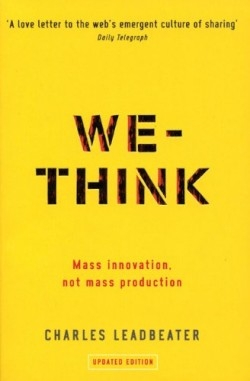We-Think
Mass Innovation, Not Mass Production
Today’s technology: a brave new world incorporating everything from blogs, YouTube, and Wikipedia to MySpace, Facebook, and Twitter. The world is at an unprecedented level of connectedness: people who likely would live an entire life never hearing of millions of people are now communicating with them through technology unheard of thirty years ago. At times it seems to be just a whole lot of cyber-noise. But there is a collective power and a world of possibility that’s barely been tapped, as Charles Leadbeater shows in his book We-Think.
Leadbeater argues persuasively that the collaborative potential of technology has not been fully explored. There are current examples, such as Wikipedia, that show what good (and sometimes not so good) can happen when people work together rather than toiling separately to collect and disperse knowledge. This can occur either in the compilation of knowl-edge, such as Wikipedia or any other open-source technology, or it can be seen in the hugely popular world of online games—not gambling, but role-playing and mystery-solving games like World of Warcraft, in which participants from around the world can play with and against each other. But the primary foundation of the We-Think concept is that users think “with” rather than “for” others.
Leadbeater is a well-respected leader on innovation and creativity, being applauded by Accenture and the New York Times for his work in this field. His enthusiasm and interest in exploring the topic is clear throughout the book; in fact, he used the development of the book as an experiment in collective knowledge by posting drafts of it online and inviting readers to comment and critique. He was not naïve enough to think there was no risk in doing so, and he addresses concerns and pitfalls that can occur when this type of collaborative effort takes place. To avoid problems and failures, Leadbeater suggests taking this approach: “We-Think takes off only by getting the right answer to each of the following question: Who contributes? What do they contribute? Why do they do so? And how do they do it?”
This highly readable, well-researched book is a great start for any person (or team) looking to find new approaches to innovation in the workplace, particularly if they are not already highly familiar with the direction technology is heading.
Disclosure: This article is not an endorsement, but a review. The publisher of this book provided free copies of the book to have their book reviewed by a professional reviewer. No fee was paid by the publisher for this review. Foreword Reviews only recommends books that we love. Foreword Magazine, Inc. is disclosing this in accordance with the Federal Trade Commission’s 16 CFR, Part 255.

